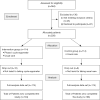Safety and efficacy of a novel quantitative phase I exercise in patients after cardiopulmonary bypass: a single-blind, prospective, non-randomized study
- PMID: 39552904
- PMCID: PMC11565311
- DOI: 10.21037/jtd-24-753
Safety and efficacy of a novel quantitative phase I exercise in patients after cardiopulmonary bypass: a single-blind, prospective, non-randomized study
Abstract
Background: Despite the positive effect of early post-cardiac surgery exercises, the concern of safety issues is high, indicating the need for standardized and quantitative mobility indicators to enhance early mobilization monitoring in the intensive care unit while ensuring patient safety. This study aimed to compare the safety and efficacy of quantitative phase I exercise versus usual care in patients who have undergone cardiac surgery.
Methods: In this non-randomized, single-blind trial, patients following on-pump cardiac surgery were allocated to either quantitative exercise (intervention group, n=114) or usual care (control group, n=114) based on their willingness. Continuous cycling ergometer was used for intervention, and the peak power was recorded for setting next exercise intensity. Noninvasive cardiac output monitoring during exercise was used for safety management. Patients received one time per day, seven sessions in total.
Results: Two-way repeated-measure analysis of variance demonstrated significant group and test time difference for forced expiratory volume in 1 s (FEV1) (P=0.01), maximum expiratory pressure (MEP) (P=0.02), peak expiratory flow (PEF) rate (P=0.045), and 6-minute walking distance (6MWD) (P=0.001); more improvement of 6MWD in intervention group (P<0.001). Intervention group showed significant post-test improvements except FEV1/forced vital capacity (FVC). Post-test differences between groups were observed in FEV1 (P=0.02), FVC (P=0.02), MEP (P=0.02), 6MWD (P<0.001), and △6MWD (P<0.001). Analysis of covariance with smoking as covariate showed consistent results. Postoperative stay in intensive-care unit in the intervention group [mean ± standard deviation (SD), 3.0±1.3] was shorter than that in the control group (mean ± SD, 3.5±2.2) (P=0.03).
Conclusions: Quantitative phase I exercise applied to patients following cardiopulmonary bypass is safe and recovers respiratory and physical capacity more quickly.
Keywords: Cardiac surgical procedures; cardiopulmonary function; early ambulation; postoperative exercise; quantitative exercise.
2024 AME Publishing Company. All rights reserved.
Conflict of interest statement
Conflicts of Interest: All authors have completed the ICMJE uniform disclosure form (available at https://jtd.amegroups.com/article/view/10.21037/jtd-24-753/coif). The authors have no conflicts of interest to declare
Figures
Similar articles
-
[Standard technical specifications for methacholine chloride (Methacholine) bronchial challenge test (2023)].Zhonghua Jie He He Hu Xi Za Zhi. 2024 Feb 12;47(2):101-119. doi: 10.3760/cma.j.cn112147-20231019-00247. Zhonghua Jie He He Hu Xi Za Zhi. 2024. PMID: 38309959 Chinese.
-
Erratum.Mult Scler. 2016 Oct;22(12):NP9-NP11. doi: 10.1177/1352458515585718. Epub 2015 Jun 3. Mult Scler. 2016. PMID: 26041800
-
Effect of Adding Early Bedside Cycling to Inpatient Cardiac Rehabilitation on Physical Function and Length of Stay After Heart Valve Surgery: A Randomized Controlled Trial.Arch Phys Med Rehabil. 2024 Jun;105(6):1050-1057. doi: 10.1016/j.apmr.2024.02.711. Epub 2024 Feb 16. Arch Phys Med Rehabil. 2024. PMID: 38367831 Clinical Trial.
-
Exploration of quantitative-effectiveness association between acupuncture temporal parameters and stable chronic obstructive pulmonary disease: A systematic review and dose-response meta-analysis of randomized controlled trials.Complement Ther Med. 2024 Jun;82:103048. doi: 10.1016/j.ctim.2024.103048. Epub 2024 May 10. Complement Ther Med. 2024. PMID: 38734186
-
Tailored or adapted interventions for adults with chronic obstructive pulmonary disease and at least one other long-term condition: a mixed methods review.Cochrane Database Syst Rev. 2021 Jul 26;7(7):CD013384. doi: 10.1002/14651858.CD013384.pub2. Cochrane Database Syst Rev. 2021. PMID: 34309831 Free PMC article.
References
LinkOut - more resources
Full Text Sources

